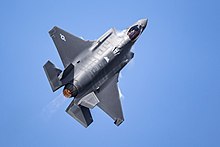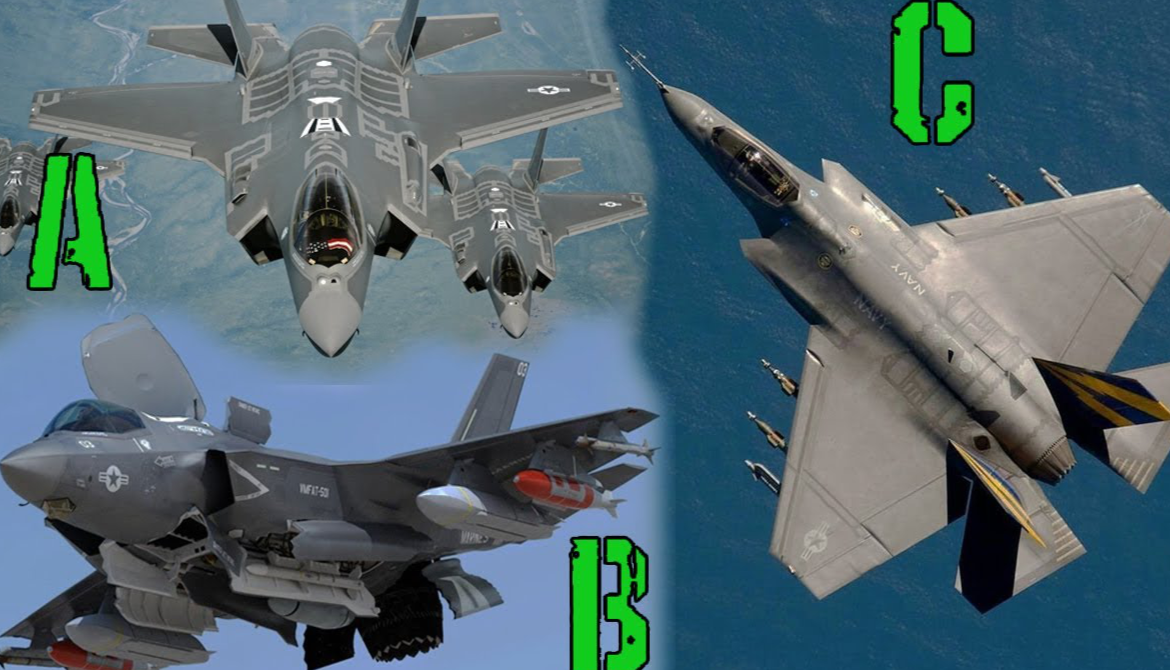Lockheed F-35 A/B/C Lightning II
 Role Role |
|
|---|---|
| National origin | United States |
| Manufacturer | Lockheed Martin |
| First flight | 15 December 2006; 17 years ago (F-35A) |
| Introduction |
|
| Status | In service |
| Primary users | United States Air Force
|
| Produced | 2006–present |
| Number built | 1,000+ |
| Developed from | Lockheed Martin X-35 |
.
History Lockheed
F-35A/B/C Lightning II
First flight 28 February 2019, Produced 2006–present
he aircraft descends from the Lockheed Martin X-35, which in 2001 beat the Boeing X-32 to win the Joint Strike Fighter (JSF) program. Its development is principally funded by the United States, with additional funding from program partner countries from the North Atlantic Treaty Organization (NATO) and close U.S. allies, including the United Kingdom, Australia, Canada, Italy, Norway, Denmark, the Netherlands, and formerly Turkey. Several other countries have also ordered, or are considering ordering, the aircraft. The program has drawn much scrutiny and criticism for its unprecedented size, complexity, ballooning costs, and much-delayed deliveries. The acquisition strategy of concurrent production of the aircraft while it was still in development and testing led to expensive design changes and retrofits.
The F-35 first flew in 2006 and entered service with the U.S. Marine Corps F-35B in July 2015, followed by the U.S. Air Force F-35A in August 2016 and the U.S. Navy F-35C in February 2019. The aircraft was first used in combat in 2018 by the Israeli Air Force ..
0
KmCeiling
0
KmCombat RANGE
0
MachAircraft Speed
0
Max Crew
Lockheed
F-35A/B/C Lightning II
Photo Gallery


Lockheed/Martin Aircraft
Lockheed
F-35A/B/C Lightning II
Lockheed Martin
- Crew: 1
- Length: 51.4 ft (15.7 m)
- Wingspan: 35 ft (11 m)
- Height: 14.4 ft (4.4 m)
- Wing area: 460 sq ft (43 m2)
Powerplant
- Empty weight: (13,290 kg)
- Gross weight: (22,471 kg)
- Max takeoff weight:(29,900 kg)
- Fuel capacity: (8,278 kg) internal
- Powerplant: 1 × Pratt & Whitney F135-PW-100 afterburning turbofan, 28,000 lbf (125 kN) thrust dry, 43,000 lbf (191 kN) with afterburner
Specifications
- Maximum speed: Mach 1.6 at altitude
- Range: 1,500 nmi (1,700 mi, 2,800 km)
-
Combat range: 669 nmi (770 mi, 1,239 km) interdiction mission (air-to-surface) on internal fuel
- 760 nmi (870 mi; 1,410 km), air-to-air configuration on internal fuel
- Service ceiling: (15,000 m)
- g limits: +9.0
- Wing loading: 107.7 lb/sq ft (526 kg/m2) at gross weight
Combat Operations
- Guns: 1 × 25 mm GAU-22/A 4-barrel rotary cannon, 180 rounds
-
Hardpoints: 4 × internal stations, 6 × external stations on wings with a capacity of 5,700 pounds (2,600 kg) internal, 15,000 pounds (6,800 kg) external, 18,000 pounds (8,200 kg) total weapons payload, with provisions to carry combinations of:
-
Missiles:
-
Air-to-air missiles:
- AIM-9X Sidewinder
- AIM-120 AMRAAM
- AIM-132 ASRAAM
- AIM-260 JATM (To be integrated)
- MBDA Meteor (Block 4, for F-35B, not before 2027) and more
-
Air-to-air missiles:
-
Missiles:
Links to Youtube & Others
American reconnaissance satellites first spotted the advanced Soviet Su-27 and MiG-29 fighter prototypes in 1978, which caused concern in the U.S. Both Soviet models were expected to reduce the maneuverability advantage of contemporary US fighter aircraft.
Lockheed/Martin
F-35A/B/C Lightning II
"The new aircraft is expected to strike targets anywhere across a continent in less than an hour."
Youtube Link
The Northrop/McDonnell Douglas YF-23, is an American single-seat, twin-engine stealth fighter aircraft technology demonstrator designed for the United States Air Force.







.png)






